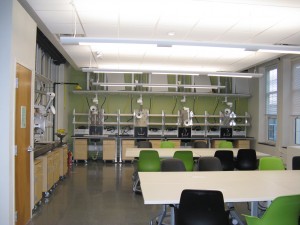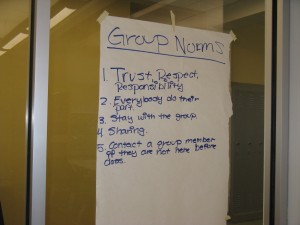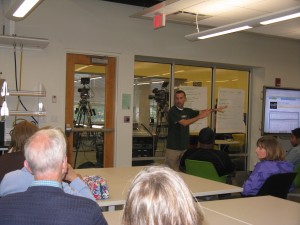Two things struck me early in a tour of new instructional space at the Legacy NewTech small school on the third floor of Heights High earlier this week, and neither has much to do with bricks and mortar. First, the space is set up in a way that serves the project-based learning approach to instruction that is at the core of Legacy. Second, students coming out of this model will be better prepared for world as it exists. Few if any employers are looking for employees who have mastered the art of sitting quietly in rows, working in isolation. The are looking for workers who not only possess job-specific expertise, but who also can successfully work in teams, structure and solve problems, and find ways to turn information into knowledge. That’s what they’re learning at Legacy.

The space at Legacy is one of three in the district that have been renovated, to show what new facilities could look like and see how well they work. The others are at Roxboro Middle School and Oxford Elementary.
To understand what’s going on at Legacy, it helps to know a bit about the New Tech Network, a unit of KnowledgeWorks. On their website, here’s how they describe their model of instruction:
New Tech Network (NTN) is a non-profit organization that helps students gain the knowledge and skills they need to succeed in life, college, and the careers of tomorrow. We work nationwide with schools, districts, and communities to provide services and support that enable schools to fundamentally re-imagine teaching and learning.
Project-based learning is at the heart of our instructional approach. In project-based learning, learning is contextual, creative, and shared. Students collaborate on projects that require critical thinking and communication. By making learning relevant to them in this way, student engagement reaches new levels. This higher level of engagement is associated with better educational outcomes.
The smart use of technology supports our innovative approach to instruction and culture. All classrooms have a one-to-one computing ratio. With access to Web-enabled computers and the latest in collaborative learning technology, every student becomes a self-directed learner who no longer needs to rely on teachers or textbooks for knowledge and direction. We use Echo, an online learning management system to create a vibrant network which helps students, teachers, and parents connect to each other, and to student projects across the country.
Finally, each New Tech school maintains a culture that promotes trust, respect, and responsibility. At New Tech schools, students and teachers alike have exceptional ownership of the learning experience and their school environment. Working on projects and in teams, students are accountable to their peers and acquire a level of responsibility similar to what they would experience in a professional work environment.
The space at Legacy was reconfigured from what was a classic double-loaded corridor, a fancy way of describing pretty much every school space you’ve ever seen: a hallway with classrooms on each side. Imagine taking three classrooms on each side of a hall and combining them. Get rid of the wall between the hall and one of those spaces, so it’s the size of three classrooms and what was the hall, and put class between this larger space (now known as the Student Think Tank) and the other space, now a Science Lab.

The move from old-style classrooms means no rows of desks, and no teacher desk up front. Teachers share space in the Teacher Think Tank. Imagine a teachers’ lounge on steroids, with plenty of space for collaboration, cubbies to work at, and yes, a coffee machine.
While the description of Echo in the quote above has a whiff of marketing jargon, seeing how the teachers and students use it suggests to me that it’s a powerful tool, and a milestone in the district’s embrace of technology.
History teacher Patrick Fisher described a combined history/science project that students are starting, called “Use Your Head or Lose Your Head,” an exploration of the Scientific Revolution and Enlightenment in which students will use current knowledge to defend the views of those who bucked conventional wisdom of the 17th and 18th centuries. Students work in groups, and depending on which teacher they work with or the task at hand, they move around, using rolling chair/desks that have space underneath for books.

Groups of students can work more independently in the Student Think Tank, as long as they show the right respect and responsibility. Students will earn ‘trust cards” as passports to use the space. Legacy has five school-wide learning outcomes: Content, Collaboration, Communication, Professional Work Ethic, and Problem Solving, and those are the basis of student grades.
I sometimes hear grumbling about the need to focus on what’s going on inside our schools, that worrying about the physical spaces is a luxury we can’t afford. Seeing what’s happening at Legacy supports my view that that’s a false distinction. The Legacy space was designed with input from teachers, who took the best of what they saw at other NewTech schools. The space supports the teaching and learning.
The new spaces at Legacy, Oxford and Rox Middle School provide a useful glimpse into what instructional space looks like when it supports the collaborative teaching going on in our schools. As a community, we will face a decision next year about what to do with all our schools, how many we need, where they are, and how they function. The school board has asked a new Lay Facilities Committee to make recommendations that will help them decide whether to put a facilities bond issue on next year’s ballot, and what the plan will look like. The Lay Facilities Committee will hold its first meeting Wednesday, Oct. 3 at 6:30pm, in the new Legacy space. The meeting is open to the public. I hope you can attend.




Leave a Reply